An Android App’s Answer to Siri
Android phones have always let you speak to type. But they’ve never had anything like Siri—or so I thought.
Then I got this note in my Inbox from a PR guy:
“Android users curious about the Siri have been flocking to Speaktoit, a free Android personal assistant app that’s already doing many of the things Siri will start to offer. In the past week, Speaktoit downloads have vaulted into the tens of thousands, growing 400% in seven days and adding 3k users a day based on word of mouth and rave reviews on the Android Market.
Like Siri, Speaktoit’s assistants can: send emails, send texts, post to Facebook, post to Twitter, check you in places, look up information, find news, look up traffic, look up weather, call people, take notes, add things to your calendar, translate foreign languages, help you find nearby places like bars (but not without reminding you to enjoy responsibly…), and tons more.
Versions for iOS and Blackberry are coming soon.”
Well! Considering all the fuss over Siri, it would seem only fair to try out an app for Android that purports to do the same thing — especially since it’s a free app.
As it turns out, SpeakToIt is indeed the same idea as Siri, but it’s nowhere near as well done. Part of that, of course, is that it’s a third-party app, not built into the phone. For example, on the iPhone, you can make Siri start listening just by holding the phone up to your ear (if you’ve turned on this option in Settings), or by holding down the Home button for a couple of seconds. SpeakToIt, on the other hand, isn’t built in—it’s an app—so you have to open it manually before you can do any voice commanding.
Once it’s open, you see a cartoon of a woman wearing a halter top and short-cropped hair — an unconventional choice, to be sure (although you can change the cartoon character). She speaks with a synthesized voice, as Siri does, and even makes a little effort at having a personality. She says something like, “Welcome back! How can I help you?”
At this point, you tap the microphone button. And you wait — much longer than you would with Siri — until the “Speak now” logo appears. Here’s what I tried to say, and what SpeakToIt’s responses were:
Me: “How do I get to the San Diego airport?” Her: “San Diego Airport Sedan is the nearest one to you.” (Huh?)
Me: “How many feet are in a mile?” Her: “One mile equals 5,280 feet.” Bingo.
Me: “Are there any good Thai restaurants near here?” Her: “This map will show you the nearest ‘are there any good thai restaurants’ to your location.” (She then showed me a tiny Google Maps map — except that it was blank. Just empty inside.)
Me: “What’s 43 times 7?” Her: “43 times 7 equals 301.” Correct.
Me: “What’s the meaning of life?” Her: “The meaning of life is a bit outside my range of expertise. For now.” Ha! Good one! (Siri has about 10 different answers to that question; SpeakToIt gives you the same reply every time.)
Me: “How are you?” Her: “Lovely, thanks.”
Me: “Remind me to bring my wallet.” Her: “Do you want me to memorize your note or do you want to save them in Evernote?” Me: “Memorize my note.” Her: “I don’t think I’m qualified to answer that yet.”
Me: “When was Abraham Lincoln born?” Her: “I couldn’t get an answer at this time.”
Me: “Where is the closest Starbucks?” Her: “These are the nearest Starbucks to your location.” (A Google map appeared, covered with pinpoints.)
Me: “What’s on my calendar today?” Her: “First things first: let’s sign into your Google calendar.” (After we did that, she would show me my appointments.)
Me: “What’s the temperature outside?” Her: “The current weather is clear, 63 degrees Fahrenheit.”
Me: “Make an appointment with Robert for 7:00 Friday.” Her: “I’m going to save ‘with robert at 7:00 Friday.’ Is this right?’”
Me: “Send a text to Casey Robin.” Her: “What would you like to say?” “Me: “I’m running late (comma), but I’ll be there as soon as I can (period). Don’t start the party without me, O.K.? That’d be terrific.” Her: “I’m running a little bit late but I’ll be there soon as I can Don’t start the party without me O.K. Deb terrific.”
Me: “Play some music.” Her: “What song would you like to listen to?” Me: “Anything.” She chose a song at random and started playing it.
Me: “Will you marry me?” Her: “I’m flattered, but surely you can find a better match than a virtual assistant.”
Me: “Wake me up at 8:20 a.m.” SpeakToIt told me that she couldn’t do that now, but that I could download a free update that would add this feature. (The company says that it plans to add new capabilities all the time.)
So I downloaded the update and opened it. But now, whenever I tapped the microphone button, SpeakToIt said only: “Sorry! The application Speaktoit Assistnat (process com.apseaktoit.assistant) has stopped unexpectedly. Please try again.”
I did. I tried over and over, and always got the same message.
Thus ended my SpeakToIt adventure, but I got the idea: SpeakToIt works, sort of. She’s slow and a little bit mentally challenged. She’s less convenient than Siri, less capable, less comprehending, less accurate, less useful, less polished, less classy, less human.
I’m not sure how many Fandroids will really incorporate SpeakToIt into their daily phone lives; the sluggishness and unreliability are a powerful disincentive. But she’s free, she works most of the time, and she brings a taste of the new virtual-minion world to the millions of Android phones.




